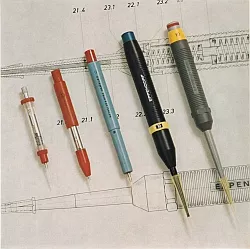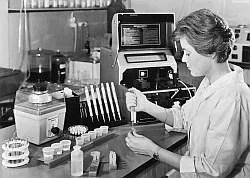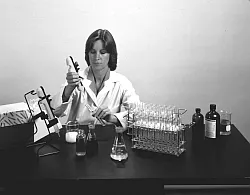08/25/2021
The 60th birthday of a pipetting masterstroke
2021 marks a key milestone for anyone working in a lab. Sixty years ago, Eppendorf changed the ways of handling liquids forever by introducing the world's first industrially manufactured piston-stroke pipette. Launched in 1961, the Eppendorf 'Marburg Pipette' featured the same basic elements as those found in today's labs: a spring-loaded piston that stops precisely at a set volume level and a removable pipette tip made of plastic.
An ingenious mind takes on a problem
Until the 1950's, scientists transferred liquids via mouth-pipetting; a technique whereby the user would suck up liquids by mouth into thin glass tubes.
Not only were these pipettes routinely cleaned with dangerous chemicals such as sulfuric acid, but anecdotal reports also linked mouth-pipetting to the ingestion of hazardous substances, including a typhoid culture and even plutonium.

- Fig.1: After the introduction of the first
'Marburg Pipette' in 1961, the piston-stroke
pipette from Eppendorf continues to
develop further.
Eppendorf recognizes the potential
Eppendorf was the first to recognize the importance of Schnitger's invention and developed it further. This work culminated in the 'Marburg Pipette' - the world's first commercial piston-stroke pipette, launched by Eppendorf in 1961. Along with the first disposable tube for handling microliter volumes (the 'Eppi'), a microliter centrifuge and a thermo-mixer, the 'Marburg Pipette' formed Eppendorf's microliter system; a revolutionary toolset in many scientific disciplines that today defines the standard in research labs all over the world.
Further investments were made in the development of the piston-stroke pipette and in 1976, the Eppendorf Comforpette 4700 pipette was presented. This was the first pipette with automatic tip ejection, which eliminated the need to handle the used tip by hand, an important mechanism, especially when working with hazardous liquids.

- Fig.2: The 'microliter system' from
Eppendorf: The holistic approach set new
standards in laboratories around the
world as early as 1963.
A promising future
An incredible 60 years has passed since Eppendorf launched the very first commercial piston-stroke pipette; a tool that has fundamentally revolutionized science. This pivotal moment means that Eppendorf's DNA is ingrained in every piston-stroke pipette manufactured since. However, the story does not end here. Eppendorf's commitment to providing the best liquid handling solutions continues to result in innovative designs that make the lab an ever-more efficient, safer and generally better place to be.

- Fig.3: The Multipette®/Combitips® system
quickly became very popular in laboratories.
High-throughput analysis inherently requires the processing of hundreds or even thousands of samples. Ensuring accurate and precise performance typically requires many pipettes that need to be calibrated regularly to perform at peak performance. This is where cloud solutions such as VisioNize Lab Suite, come in, helping lab managers keep track of their instruments and samples and schedule the next pipette calibration with just a few clicks.
60 Years Pipette Anniversary
Today, Eppendorf customers can choose from a broad range of instruments, consumables, and services to suit their liquid handling needs and further accelerate their research.
To celebrate the occasion, Eppendorf has taken a look at how pipetting has evolved over the years and where we're headed for the future of liquid handling.
